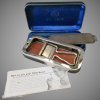Hello, all. So I've been trying to find a bit more information on the popularity of safety razors in the UK during the early 1920s. Thus far, I've learned that safety razors were very popular in the US, chiefly due to Gillette's army kits during WWI. But I've had a harder time finding information on their use and popularity at the same time period in the UK. Anyone know any good web resources on the subject or care to share their knowledge? What kinds of shaving kits (if any) did the British army issue their soldiers in WWI? Were men in the UK in the 1920s using safety razors or were they still using straight razors? And was it divided by economic sphere? Would, for instance, a working man be more likely to use a safety razor? Would the upper crust turn their noses up at it?
You are using an out of date browser. It may not display this or other websites correctly.
You should upgrade or use an alternative browser.
You should upgrade or use an alternative browser.
History Question: Popularity of Safety Razors During the 1920s
- Thread starter JaneDoe
- Start Date
- Messages
- 269
If you watch "They Shall Not Grow Old" (the documentary by Peter Jackson) there are a number of references to the straight razors they were using both in the commentary and films of them shaving. The soldiers say that the razors were poor quality, however collectors who have these razors have found the opposite which probably implies the soldiers didn't have the means or knowledge to sharpen them.
- Thread Starter
- #3
If you watch "They Shall Not Grow Old" (the documentary by Peter Jackson) there are a number of references to the straight razors they were using both in the commentary and films of them shaving. The soldiers say that the razors were poor quality, however collectors who have these razors have found the opposite which probably implies the soldiers didn't have the means or knowledge to sharpen them.
Thanks for replying! I've heard quite a bit about the documentary you mentioned and will watch it soon.
- Messages
- 3,671
- Location
- Surrey, UK
- Messages
- 269
At least two in my family. My grandfather would hone his on the back of the bath where the enamel had worn down."Rolls razor" were incredibly popular over here, basically a small segment of straight razor on a metal stick. They are so prevalent and were manufactured for so long that it's almost impossible to enter a charity shop or boot sale without stumbling upon at least one.
View attachment 48303
- Messages
- 7,011
As an historian by education I have a few wonderful analogies that I shall use as examples. For instance, the percussion cap was invented circa 1822, but people nor armies did not frantically throw away their flintlocks overnight to change over any moreso than did people with horses when automobiles were invented. As a matter of fact, the British Army first toyed with percussion rifle issuance in 1840, but did not do so wholesale until the mid 1850's with the Enfield Pattern 1851 Minié Rifle. I think today we view any historical technological change as we do people today upgrading a cell phone or a computer when in reality it was almost always a gradual shift over time.
- Thread Starter
- #7
Thanks very much for the info!"Rolls razor" were incredibly popular over here, basically a small segment of straight razor on a metal stick. They are so prevalent and were manufactured for so long that it's almost impossible to enter a charity shop or boot sale without stumbling upon at least one.
View attachment 48303
- Thread Starter
- #8
Well said. Thanks for the reply!As an historian by education I have a few wonderful analogies that I shall use as examples. For instance, the percussion cap was invented circa 1822, but people nor armies did not frantically throw away their flintlocks overnight to change over any moreso than did people with horses when automobiles were invented. As a matter of fact, the British Army first toyed with percussion rifle issuance in 1840, but did not do so wholesale until the mid 1850's with the Enfield Pattern 1851 Minié Rifle. I think today we view any historical technological change as we do people today upgrading a cell phone or a computer when in reality it was almost always a gradual shift over time.
- Thread Starter
- #9
Thanks for chiming in! I appreciate the info.At least two in my family. My grandfather would hone his on the back of the bath where the enamel had worn down.
- Messages
- 33
the change in military gear cannot be used to reference the adaptation of ANYTHING in the civilian world. Most of the civilian world had switch to percussion very quickly.
look at the number of different brands of single and double edge razor patents from Europe in the 1900 to 1920 range. they switched fast.
look at the number of different brands of single and double edge razor patents from Europe in the 1900 to 1920 range. they switched fast.
- Thread Starter
- #11
the change in military gear cannot be used to reference the adaptation of ANYTHING in the civilian world. Most of the civilian world had switch to percussion very quickly.
look at the number of different brands of single and double edge razor patents from Europe in the 1900 to 1920 range. they switched fast.
Thanks very much for your reply!

